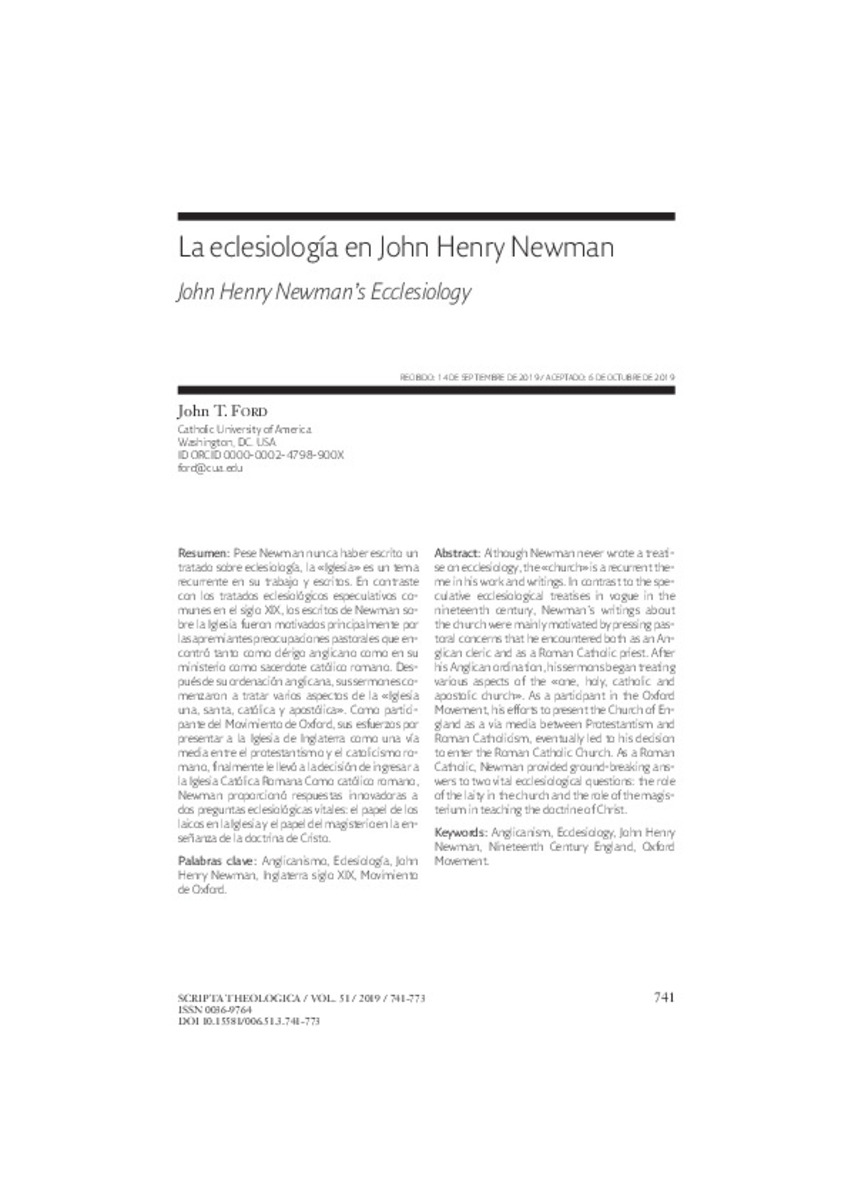Full metadata record
| DC Field | Value | Language |
|---|---|---|
| dc.creator | Ford, J.T. (John T.) | - |
| dc.date.accessioned | 2019-12-09 | - |
| dc.date.accessioned | 2023-01-25T10:30:37Z | - |
| dc.date.available | 2023-01-25T10:30:37Z | - |
| dc.date.issued | 2019 | - |
| dc.identifier.citation | Ford, J.T. (John T.). "John Henry Newman’s Ecclesiology". . 51 (3), 2019, 741 - 773 | es |
| dc.identifier.issn | 0036-9764 | - |
| dc.identifier.uri | https://hdl.handle.net/10171/65156 | - |
| dc.description.abstract | Although Newman never wrote a treatise on ecclesiology, the «church» is a recurrent theme in his work and writings. In contrast to the speculative ecclesiological treatises in vogue in the nineteenth century, Newman’s writings about the church were mainly motivated by pressing pastoral concerns that he encountered both as an Anglican cleric and as a Roman Catholic priest. After his Anglican ordination, his sermons began treating various aspects of the «one, holy, catholic and apostolic church». As a participant in the Oxford Movement, his efforts to present the Church of England as a via media between Protestantism and Roman Catholicism, eventually led to his decision to enter the Roman Catholic Church. As a Roman Catholic, Newman provided ground-breaking answers to two vital ecclesiological questions: the role of the laity in the church and the role of the magisterium in teaching the doctrine of Christ. | en_US |
| dc.description.abstract | Pese Newman nunca haber escrito un tratado sobre eclesiología, la «Iglesia» es un tema recurrente en su trabajo y escritos. En contraste con los tratados eclesiológicos especulativos comunes en el siglo XIX, los escritos de Newman sobre la Iglesia fueron motivados principalmente por las apremiantes preocupaciones pastorales que encontró tanto como clérigo anglicano como en su ministerio como sacerdote católico romano. Después de su ordenación anglicana, sus sermones comenzaron a tratar varios aspectos de la «Iglesia una, santa, católica y apostólica». Como participante del Movimiento de Oxford, sus esfuerzos por presentar a la Iglesia de Inglaterra como una vía media entre el protestantismo y el catolicismo romano, finalmente le llevó a la decisión de ingresar a la Iglesia Católica Romana Como católico romano, Newman proporcionó respuestas innovadoras a dos preguntas eclesiológicas vitales: el papel de los laicos en la Iglesia y el papel del magisterio en la enseñanza de la doctrina de Cristo. | es_ES |
| dc.language.iso | eng | - |
| dc.publisher | Servicio de Publicaciones de la Universidad de Navarra | es_ES |
| dc.rights | info:eu-repo/semantics/openAccess | es_ES |
| dc.subject | Anglicanismo | - |
| dc.subject | Eclesiología | - |
| dc.subject | John Henry Newman | - |
| dc.subject | Inglaterra siglo XIX | - |
| dc.subject | Movimiento de Oxford | - |
| dc.title | John Henry Newman’s Ecclesiology | en_US |
| dc.title.alternative | La eclesiología en John Henry Newman | es_ES |
| dc.type | info:eu-repo/semantics/article | es_ES |
| dc.identifier.doi | 10.15581/006.51.3.741-773 | - |
| dadun.citation.endingPage | 773 | - |
| dadun.citation.number | 3 | - |
| dadun.citation.number | Scripta Theologica | - |
| dadun.citation.startingPage | 741 | - |
| dadun.citation.volume | 51 | - |
Files in This Item:
Statistics and impact
Items in Dadun are protected by copyright, with all rights reserved, unless otherwise indicated.






